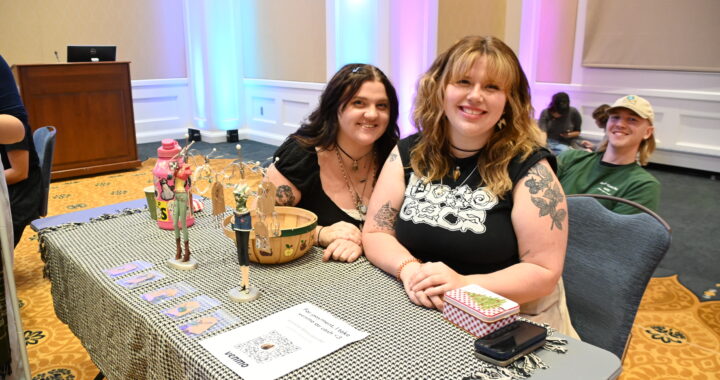Preserving an artistic tradition
3 min readOn Tuesday, Nov. 10 in Lee Hall, as part of Asian Culture Week, Yoshiko Oishi-Weick gave a lecture and demonstration of Sumi-e, the traditional Japanese style painting she practices.
Sumi-e art is characterized by the use of black ink on rice paper, with color being used sparingly, if at all. It has been practiced in Japan for centuries and is one of its oldest fine-art forms.
Oishi-Weick has studied Sumi-e since 1980 and has had her work displayed at galleries around the world including Tokyo, Beijing, Seoul and Paris.
“My love of nature and all of God’s creation was my inspiration for painting over 30 years ago,” she said. “God gave me a wonderful gift I cannot deny.”
Oishi-Weick’s artwork was displayed on several tables that lined the walls of the room, with a myriad of brushes, water and paint set on the floor for the demonstration. As people entered, Weick introduced and shook hands with each person, smiling and thanking them for attending.
The presentation began with a slideshow and a lecture from Weick on the nature of Sumi-e art and her development of the skill that it takes to produce it. Detailing the process and intricacy of Sumi-e, Oishi-Weick described this art form that is unique to Asia.
“Variations in black and gray brush strokes are used to create detail,” she said. “This flow is interesting and creates tone. The painting comes to life as if the colors are there.”
The sizes of brushes range drastically, made from the hair of many different animals and birds. The selection of the brush is used to create various tones and effects on the paper. Additionally, the quality of the paper affects how the ink is absorbed.
“With proper brushes, it is easy to create various shades,” Oishi-Weick said. “The beauty is formed in the artists soul and mind to create fresh views of nature. It is the art of expressing very deep and complicated ideas in only black and white.”
Smiling as she spoke, Oishi-Weick described her love of painting that encompasses natural depictions of landscapes, calligraphy and abstractions.
“In some of my early paintings I concentrated on abstraction, but now I concentrate on the beauty of nature. But my heart is in abstraction, it is truly beautiful,” she said.
Ending the lecture with a poem she wrote, Oishi-Weick encouraged those in the audience to follow their dreams.
“I firmly believe that when you have dreams and purpose in your life, those dreams will come true,” she said. “Nature is beautiful, life is beautiful, love is beautiful.”
Barefoot, Oishi-Weick crouched on the newspaper-covered ground and poured ink into small ceramic dishes in preparation for the demonstration. Buckets of water to dilute the ink surrounded several sheets of rice paper, along with brushes of all different sizes.
The room fell silent as she stood poised, brush in hand, above the empty sheet of rice paper. For several seconds, she did not move, but stood with the ink and brush ready to make contact with the paper. In four quick brush strokes, the first piece was completed. Holding it up, she challenged the students to interpret the artwork.
“Somebody, please talk to me, what do you think?” she said. Responding by raising hands, many students contributed their interpretation of the simple abstraction.
“It means, here at UMW… we learn, we study,” Oishi-Weick said.
Calling for a volunteer, Oishi-Weick had one student grind the black ink for the next painting by spreading a block shaped tool around in a square box on the floor. Oishi-Weick painted bamboo, mushrooms, a flower, and the verse John 14:6 in calligraphy, explaining the intricacies required for each different picture as she stood over the papers.
“The amount of water used depends on what is being drawn,” she said. “It takes time, patience, and meditation to paint well.”
To end the demonstration, Oishi-Weick gave away one of the paintings she had produced during the evening to Edmund Brown, the winner of a group rock-paper-scissors contest. Smiling and thanking everyone, Oishi-Weick’s passion for her art filled the room.
“I want to inform the world about the profound beauty of the Sumi-e art form,” she said. “To paint in the India ink, to live with it, is my only desire.”


